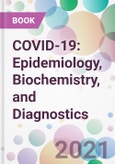COVID-19: Epidemiology, Biochemistry, and Diagnostics explains COVID-19 from multidisciplinary angles such as the evolution of SARS-COV, genetic techniques to study the virus, and diagnostic methodologies widely used in the global COVID-19 pandemic.
II) Genetic Alteration and Structural Determination of SARS-CoV-2 Proteins
III) Quantitative Analysis of SARS-CoV-2 for research and medical diagnosis
Readers will understand the significance of phylogenetic analysis of coronaviruses, along with the pathogenesis of COVID-19 and related diseases such as SARS and MERS. Applications of biochemical technologies such as RT-PCR and CRISPR are also demonstrated in the text. This book is a comprehensive introduction to COVID-19 research for medical researchers, microbiologists and virologists. Students in academic programs in life sciences and medicine will also benefit from the information provided in the book.
The chapters in this book provide the reader with up-to-date literature about research on SARS-CoV-2 through three parts:
I) Evolution and Entry of SARS-CoV-2 into the hostII) Genetic Alteration and Structural Determination of SARS-CoV-2 Proteins
III) Quantitative Analysis of SARS-CoV-2 for research and medical diagnosis
Key Features
- 15 chapters on SAR-CoV-2 in a multidisciplinary context
- Provides a comprehensive overview of SARS-CoV-2 evolution and genetics
- Provides biochemical information about SARS-CoV-2 proteins and receptor targets (both structural and non-structural proteins)
- Includes an overview of several methods of detecting SARS-CoV-2 virus particles (ELISA, PCR, Neutralizing Antibodies
- Covers some critical diagnostic modalities for COVID-19 diagnosis
- Provides bibliographic references for further reading
Readers will understand the significance of phylogenetic analysis of coronaviruses, along with the pathogenesis of COVID-19 and related diseases such as SARS and MERS. Applications of biochemical technologies such as RT-PCR and CRISPR are also demonstrated in the text. This book is a comprehensive introduction to COVID-19 research for medical researchers, microbiologists and virologists. Students in academic programs in life sciences and medicine will also benefit from the information provided in the book.
Table of Contents
PART 1 PART I: EVOLUTION AND ENTRY OF SARS-COV-2
- Chapter 1 Coronavirus Disease-2019 (COVID- 19) Epidemiology
- Chapter 2 Studying Evolutionary Adaptation of Sars-Cov-2
- Chapter 3 Evaluating Sars-Cov-2 Entry Pathways
PART 2 PART II: GENETIC ALTERATION AND STRUCTURAL DETERMINATION OF SARS-COV-2 PROTEINS
- Chapter 4 Genomic Characterization of Sars-Cov-2
- Chapter 5 Mutation of Sars-Cov-2
- Chapter 6 Biochemical Characterization of Sars-Cov-2 Spike Protein Proteolytic Processing
- Chapter 7 Crystal Structure Determination and Receptor Recognition Basis of Sars-Cov-2 Spike Glycoprotein
- Chapter 8 Structural Elucidation of Sars-Cov-2 Accessory Proteins
PART 3 PART III: QUANTITATION ANALYSIS OF SARS-COV-2
- Chapter 9 Antigen Capture Enzyme-Linked Immunosorbent Assay (Elisa) for the Detection of the Novel Sars-Cov-2 in Humans
- Chapter 10 Quantification of the Sars-Cov-2 Rna in Tissues by Quantitative Real Time-Pcr
- Chapter 11 Evaluation of Sars-Cov-2 Neutralizing Antibodies in Sera Using Live Virus Microneutralization Assay
- Chapter 12 Pseudovirus Neutralization Assay for Sars-Cov-
- Chapter 13 Quantitative and Qualitative Determination of COVID-19 (Sars-Cov-2) Specific Antibodies Using Elisa
- Chapter 14 Chest Ct Scan: An Ideal Diagnostic Tool for COVID-19
- Chapter 15 Nucleic Acid-Based Detection of COVID-19
Subject Index
Author
- Kamal Niaz
- Muhammad Farrukh Nisar








